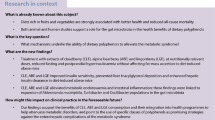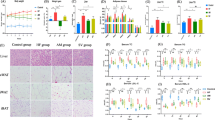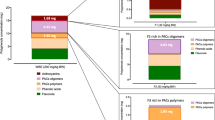Abstract
Purpose
Blueberry and cranberry are rich in anthocyanins. The present study was to investigate the effects of anthocyanin extracts from blueberry and cranberry on body weight and gut microbiota.
Methods
C57BL/6 J Mice were divided into six groups (n = 9 each) fed one of six diets namely low-fat diet (LFD), high-fat diet (HFD), HFD with the addition of 1% blueberry extract (BL), 2% blueberry extract (BH), 1% cranberry extract (CL), and 2% cranberry extract (CH), respectively.
Results
Feeding BL and BH diets significantly decreased body weight gain by 20–23%, total adipose tissue weight by 18–20%, and total liver lipids by 16–18% compared with feeding HFD. Feeding CH diet but not CL diet reduced the body weight by 27%, accompanied by a significant reduction of total plasma cholesterol by 25% and tumor necrosis factor alpha (TNF-α) by 38%. The metagenomic analysis showed that the supplementation of blueberry and cranberry anthocyanin extracts reduced plasma lipopolysaccharide concentration, accompanied by a reduction in the relative abundance of Rikenella and Rikenellaceae. Dietary supplementation of berry anthocyanin extracts promoted the growth of Lachnoclostridium, Roseburia, and Clostridium_innocuum_group in genus level, leading to a greater production of fecal short-chain fatty acids (SCFA).
Conclusions
It was concluded that both berry anthocyanins could manage the body weight and favorably modulate the gut microbiota at least in mice.







Similar content being viewed by others
References
World Health Organization (2018) Obesity and overweight. https://www.who.int/news-room/fact-sheets/detail/obesity-and-overweight
Pi-Sunyer FX (2002) The obesity epidemic: pathophysiology and consequences of obesity. Obes Res 10(S12):97S-104S
Mulders R, de Git K, Schele E, Dickson S, Sanz Y, Adan R (2018) Microbiota in obesity: interactions with enteroendocrine, immune and central nervous systems. Obes Rev 19(4):435–451
THMP Consortium (2012) Structure, function and diversity of the healthy human microbiome. Nature 486(7402):207–214
Guinane CM, Cotter PD (2013) Role of the gut microbiota in health and chronic gastrointestinal disease: understanding a hidden metabolic organ. Ther Adv Gastroenterol 6:295–308
Klimesova K, Kverka M, Zakostelska Z, Hudcovic T, Hrncir T, Stepankova R, Rossmann P, Ridl J, Kostovcik M, Mrazek J, Kopecny J, Kobayashi KS, Tlaskalova-Hogenova H (2013) Altered gut microbiota promotes colitis-associated cancer in IL-1 receptor–associated kinase M–deficient mice. Inflamm Bowel DIS 19(6):1266–1277
Patterson E, Ryan PM, Cryan JF, Dinan TG, Ross RP, Fitzgerald GF, Stanton C (2016) Gut microbiota, obesity and diabetes. Postgrad Med J 92(1087):286–300
Shin NR, Whon TW, Bae JW (2015) Proteobacteria: microbial signature of dysbiosis in gut microbiota. Trends Biotechnol 33:496–503
Shang Q, Song G, Zhang M, Shi J, Xu C, Hao J, Li G, Yu G (2017) Dietary fucoidan improves metabolic syndrome in association with increased Akkermansia population in the gut microbiota of high-fat diet-fed mice. J Funct Foods 28:138–146
Liu J, He Z, Ma N, Chen Z-Y (2019) Beneficial effects of dietary polyphenols on high-fat diet-induced obesity linking with modulation of gut microbiota. J Agric Food Chem 68(1):33–47
Blaut M, Clavel T (2007) Metabolic diversity of the intestinal microbiota: implications for health and disease. J Nutr 137(3):751S-755S
Peron G, Hidalgo-Liberona N, González-Domínguez R, Garcia-Aloy M, Guglielmetti S, Bernardi S, Kirkup B, Kroon A, Cherubini A, Riso P, Andrés-Lacueva C (2019) Exploring the molecular pathways behind the effects of nutrients and dietary polyphenols on gut microbiota and intestinal permeability: a perspective on the potential of metabolomics and future clinical applications. J Agri Food Chem 68(7):1780–1789
Hithamani G, Srinivasan K (2014) Effect of domestic processing on the polyphenol content and bioaccessibility in finger millet (Eleusine coracana) and pearl millet (Pennisetum glaucum). Food Chem 164:55–62
Jamar G, Estadella D, Pisani LP (2017) Contribution of anthocyanin-rich foods in obesity control through gut microbiota interactions. BioFactors 43(4):507–516
Tian L, Tan Y, Chen G, Wang G, Sun J, Ou S, Chen W, Bai W (2018) Metabolism of anthocyanins and consequent effects on the gut microbiota. Crit Rev Food Sci Nutr 59(6):982–991
Guglielmetti S, Fracassetti D, Taverniti V, Del Bo C, Vendrame S, Klimis-Zacas D, Arioli S, Riso P, Porrini M (2013) Differential modulation of human intestinal bifidobacterium populations after consumption of a wild blueberry (Vaccinium angustifolium) drink. J Agric Food Chem 61(34):8134–8140
Jiao X, Wang Y, Lin Y, Lang Y, Li E, Zhang X, Zhang Q, Feng Y, Meng X, Li B (2019) Blueberry polyphenols extract as a potential prebiotic with anti-obesity effects on C57BL/6 J mice by modulating the gut microbiota. J Nutr Biochem 64:88–100
Anhê FF, Roy D, Pilon G, Dudonné S, Matamoros S, Varin TV, Garofalo C, Moine Q, Desjardins Y, Levy E (2015) A polyphenol-rich cranberry extract protects from diet-induced obesity, insulin resistance and intestinal inflammation in association with increased Akkermansia spp. population in the gut microbiota of mice. Gut 64(6):872–883
Rodríguez-Morató J, Matthan NR, Liu J, de la Torre R, Chen C-YO (2018) Cranberries attenuate animal-based diet-induced changes in microbiota composition and functionality: a randomized crossover controlled feeding trial. J Nutr Biochem 62:76–86
He WS, Cui D, Li L, Rui J, Tong LT (2020) Plasma triacylglycerol-reducing activity of ergosterol linolenate is associated with inhibition of intestinal lipid absorption. J Funct Foods 64:103686
Zhao Y, He Z, Hao W, Zhu H, Liang N, Liu J, Zhang C, Ma KY, He WS, Yang Y (2020) Vinegars but not acetic acid are effective in reducing plasma cholesterol in hamsters fed a high-cholesterol diet. Food Funct 11(3):2163–2172
Liu J, Hao W, He Z, Kwek E, Zhao Y, Zhu H, Liang N, Ma KY, Lei L, He WS (2019) Beneficial effects of tea water extracts on the body weight and gut microbiota in C57BL/6J mice fed with a high-fat diet. Food Funct 10(5):2847–2860
Zhao Y, Liu J, Hao W, Zhu H, Liang N, He Z, Ma KY, Chen ZY (2017) Structure-specific effects of short-chain fatty acids on plasma cholesterol concentration in male Syrian hamsters. J Agric Food Chem 65(50):10984–10992
Hao W, Kwek E, He Z, Zhu H, Liu J, Zhao Y, Ma KY, He WS, Chen ZY (2020) Ursolic acid alleviates hypercholesterolemia and modulates gut microbiota in Hamsters. Food Func 1:9–23
Wang J, Wang P, Li D, Hu X, Chen F (2020) Beneficial effects of ginger on prevention of obesity through modulation of gut microbiota in mice. Eur J Nutr 59(2):699–718
Wu T, Jiang Z, Yin J, Long H, Zheng X (2016) Anti-obesity effects of artificial planting blueberry (Vaccinium ashei) anthocyanin in high-fat diet-treated mice. Int J Food Sci Nutr 67(3):257–264
Ghattamaneni NK, Sharma A, Panchal SK, Brown L (2019) Pelargonidin 3-glucoside-enriched strawberry attenuates symptoms of DSS-induced inflammatory bowel disease and diet-induced metabolic syndrome in rats. Eur J Nutr 1:14
Kim AY, Jeong YJ, Park YB, Lee MK, Jeon SM, McGregor RA, Choi MS (2012) Dose dependent effects of lycopene enriched tomato-wine on liver and adipose tissue in high-fat diet fed rats. Food Chem 130(1):42–48
Rojo LE, Ribnicky D, Logendra S, Poulev A, Rojas-Silva P, Kuhn P, Dorn R, Grace MH, Lila MA, Raskin I (2012) In vitro and in vivo anti-diabetic effects of anthocyanins from Maqui Berry (Aristotelia chilensis). Food Chem 131(2):387–396
Prior RL, Wu X, Gu L, Hager T, Hager A, Wilkes S, Howard L (2009) Purified berry anthocyanins but not whole berries normalize lipid parameters in mice fed an obesogenic high fat diet. Mol Nutr Food Res 53(11):1406–1418
Kowalska K, Olejnik A (2016) Beneficial effects of cranberry in the prevention of obesity and related complications: Metabolic syndrome and diabetes–a review. J Funct foods 20:171–181
Reagan-Shaw S, Nihal M, Ahmad N (2008) Dose translation from animal to human studies revisited. FASEB J 22(3):659–661
Hassellund SS, Flaa A, Sandvik L, Kjeldsen SE, Rostrup M (2012) Effects of anthocyanins on blood pressure and stress reactivity: a double-blind randomized placebo-controlled crossover study. J Hum Hypertens 26(6):396–404
You Y, Han X, Guo J, Guo Y, Yin M, Liu G, Huang W, Zhan J (2018) Cyanidin-3-glucoside attenuates high-fat and high-fructose diet-induced obesity by promoting the thermogenic capacity of brown adipose tissue. J Funct Foods 41:62–71
Chang CJ, Lin CS, Lu CC, Martel J, Ko YF, Ojcius DM, Tseng SF, Wu TR, Chen YM, Young JD, Lai HC (2017) Corrigendum: Ganoderma lucidum reduces obesity in mice by modulating the composition of the gut microbiota. Nat Commun 8:16130
Wu S, Yano S, Chen J, Hisanaga A, Sakao K, He X, He J, Hou D-X (2017) Polyphenols from Lonicera caerulea L. berry inhibit LPS-induced inflammation through dual modulation of inflammatory and antioxidant mediators. J Agric Food Chem 65(25):5133–5141
Lin HV, Frassetto A, Kowalik EJ Jr, Nawrocki AR, Lu MM, Kosinski JR, Hubert JA, Szeto D, Yao X, Forrest G, Marsh DJ (2012) Butyrate and propionate protect against diet-induced obesity and regulate gut hormones via free fatty acid receptor 3-independent mechanisms. PLoS ONE 7(4):e35240
Chambers ES, Viardot A, Psichas A, Morrison DJ, Murphy KG, Zac-Varghese SE, MacDougall K, Preston T, Tedford C, Finlayson G, Blundell JE, Bell JD, Thomas EL, Mt-lsa S, Ashby D, Gibson GR, Kolida S, Dhillo WS, Bloom SR, Morley W, Clegg S, Frost G (2015) Effects of targeted delivery of propionate to the human colon on appetite regulation, body weight maintenance and adiposity in overweight adults. Gut 64(11):1744–1754
den Besten G, Bleeker A, Gerding A, van Eunen K, Havinga R, van Dijk TH, Oosterveer MH, Jonker JW, Groen AK, Reijngoud DJ, Bakker BM (2015) Short-chain fatty acids protect against high-fat diet-induced obesity via a PPARγ-dependent switch from lipogenesis to fat oxidation. Diabetes 64(7):2398–2408
Anhê FF, Nachbar RT, Varin TV, Vilela V, Dudonné S, Pilon G, Fournier M, Lecours M-A, Desjardins Y, Roy D (2017) A polyphenol-rich cranberry extract reverses insulin resistance and hepatic steatosis independently of body weight loss. Mol Metab 6(12):1563–1573
Ley RE, Backhed F, Turnbaugh P, Lozupone CA, Knight RD, Gordon JI (2005) Obesity alters gut microbial ecology. Proc Natl Acad Sci USA 102(31):11070–11075
Turnbaugh PJ, Bäckhed F, Fulton L, Gordon JI (2008) Diet-induced obesity is linked to marked but reversible alterations in the mouse distal gut microbiome. Cell Host Microbe 3(4):213–223
Lee S, Keirsey KI, Kirkland R, Grunewald ZI, Fischer JG, de La Serre CB (2018) Blueberry supplementation influences the gut microbiota, inflammation, and insulin resistance in high-fat-diet-fed rats. J Nutr 148(2):209–219
Abdulamir AS, Hafidh RR, Bakar FA (2011) The association of Streptococcus bovis/gallolyticus with colorectal tumors: the nature and the underlying mechanisms of its etiological role. J Exp Clin Cancer Res 30(1):1–13
Qiao Y, Sun J, Xie Z, Shi Y, Le G (2014) Propensity to high-fat diet-induced obesity in mice is associated with the indigenous opportunistic bacteria on the interior of Peyer’s patches. J Clin Biochem Nutr 55(2):120–128
He WS, Li L, Rui J, Li J, Sun Y, Cui D, Xu B (2020) Tomato seed oil attenuates hyperlipidemia and modulates gut microbiota in C57BL/6J mice. Food Funct 23:6–12
Liu H-X, Rocha CS, Dandekar S, Wan Y-JY (2016) Functional analysis of the relationship between intestinal microbiota and the expression of hepatic genes and pathways during the course of liver regeneration. J hepatol 64(3):641–650
Daniel H, Gholami AM, Berry D, Desmarchelier C, Hahne H, Loh G, Mondot S, Lepage P, Rothballer M, Walker A (2014) High-fat diet alters gut microbiota physiology in mice. ISME J 8(2):295–308
Langille MG, Meehan CJ, Koenig JE, Dhanani AS, Rose RA, Howlett SE, Beiko RG (2014) Microbial shifts in the aging mouse gut. Microbiome 2(1):50
Khan I, Huang G, Li X-a, Liao W, Leong WK, Xia W, Bian X, Wu J, Hsiao WW (2019) Mushroom polysaccharides and jiaogulan saponins exert cancer preventive effects by shaping the gut microbiota and microenvironment in ApcMin/+ mice. Pharmacol Res 148:104448
Barcenilla A, Pryde SE, Martin JC, Duncan SH, Stewart CS, Henderson C, Flint HJ (2000) Phylogenetic relationships of butyrate-producing bacteria from the human gut. Appl Environ Microbiol 66(4):1654–1661
Duncan SH, Barcenilla A, Stewart CS, Pryde SE, Flint HJ (2002) Acetate utilization and butyryl coenzyme A (CoA): acetate-CoA transferase in butyrate-producing bacteria from the human large intestine. Appl Environ Microbiol 68(10):5186–5190
Louis P, Duncan SH, McCrae SI, Millar J, Jackson MS, Flint HJ (2004) Restricted distribution of the butyrate kinase pathway among butyrate-producing bacteria from the human colon. J Bacteriol 186(7):2099–2106
Gibson GR, Roberfroid MB (1995) Dietary modulation of the human colonic microbiota: introducing the concept of prebiotics. J Nutr 125(6):1401–1412
Collins B, Hoffman J, Martinez K, Grace M, Lila MA, Cockrell C, Nadimpalli A, Chang E, Chuang CC, Zhong W, Mackert J, Shen W, Cooney P, Hopkins R, Mackert J (2016) A polyphenol-rich fraction obtained from table grapes decreases adiposity, insulin resistance and markers of inflammation and impacts gut microbiota in high-fat-fed mice. J Nutr Biochem 31:150–165
Acknowledgements
This project was supported by a GRF grant of Hong Kong University Grants Committee (Project title:14105820).
Author information
Authors and Affiliations
Corresponding author
Ethics declarations
Conflict of interest
The authors confirm that they have no conflicts of interest with respect to the work described in this manuscript.
Rights and permissions
About this article
Cite this article
Liu, J., Hao, W., He, Z. et al. Blueberry and cranberry anthocyanin extracts reduce bodyweight and modulate gut microbiota in C57BL/6 J mice fed with a high-fat diet. Eur J Nutr 60, 2735–2746 (2021). https://doi.org/10.1007/s00394-020-02446-3
Received:
Accepted:
Published:
Issue Date:
DOI: https://doi.org/10.1007/s00394-020-02446-3




